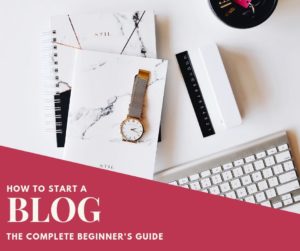The Ultimate Blogging Strategy For Beginners – 90 Days To Blogging Success
I am an affiliate with links to an online retailer in this blog post. When you read what I have written about a particular product and click on that link and buy something from the retailer, I can earn a commission. Please note that I only recommend products that I truly believe in and use in my business. Please read my full disclaimer here
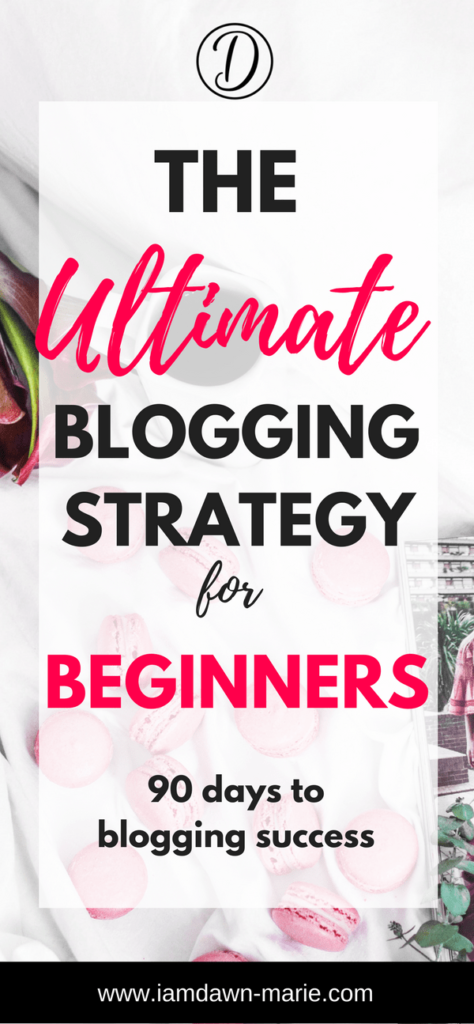 Starting a blog does not have to be hard at all.
Starting a blog does not have to be hard at all.
Wait scratch what I just said. Starting a SUCCESSFUL blog does not have to be hard at all. If you have the right design, the right content and a strategy for getting readers to your blog, you can build a successful blog that makes money in no time.
Now I am not saying it’s going to be easy.
It’s definitely going to be a lot of work. But hey! The most successful entrepreneurs had to dig their heels into the sand and work their butts off before they got tangible results.
So if that means temporary blood, sweat and tears for long term massive gain then why not? Would you be willing to take the plunge.
So I have decided to write this post to help new beginners start their blog by giving a step by step strategy to help you grow your blog within 90 days. Of course what happens after the 90 days is up to you but I’ll let you in on something.
If you have used the tips from this strategy to start your blog then it’s just a matter of repeating the entire process again and again.
Now before I start I think it is important to address a few disclaimers here. I am not saying that you will make money by following this strategy. I cannot guarantee that you will make any money. But any blog, when crafted properly has the potential to make money.
I started making money in my first month of blogging which is why I know the strategies that I outline here will help you.
Secondly I do not know who you are that is reading this. I do not know how well you deal with struggle (because there will be lots of that). I do not what type of drive you have. I do not know your motivation levels. But certainly if you are the go-getter, badass wanna-do-something good for yourself type of person, then you can make money with your blog! Simple.
So with that being said let’s get started.
The Ultimate Blogging Strategy For Beginners – 90 Days To Blogging Success
What you will learn
- How To Start A Blog
- What To Blog About – Choosing Your Niche
- How To Define Your Goal For Your Blog
- How To Blog With Your Goal In Mind
- How To Find Content That Your Audience Wants
- How To Start Writing Your First Blog Post
- How Many Blog Posts Should You Write?
- How To Monetise Your Blog
- How To Promote Your Blog Posts To Get Eyes On Your Blog
First questions
Before you start writing a blog, there are a few questions you should ask yourself and a few expectations that you should set in your mind.
This is important because sometimes when you are doing something that is showing no financial growth you can get discouraged and give up on your plan.
Therefore here are some questions you should think about:
- Do you like writing?
- Can you commit to writing for at least 90 days with no monetary return?
- The content that you intend to write about, do you enjoy it? You want to write something that you’re knowledgeable about because I find that it is easier for word flow.
If your answer to any of these questions is no, then you may want to reconsider starting a blog. Starting a blog may not be the best thing for you because you will start writing but your efforts will slow down until one day you no longer have the motivation to continue writing.
If you have answered yes, then great. I have your attention so let’s continue.
I also want to set some expectations for you as you start on this blogging journey.
- Blogging can get lonely
- There will be times when you will doubt whether your blog will ever make you money
- Sometimes no one will read your blog
- Sometimes you may not know what to write
- Blogging is hard, hard work!
As long as you get that and you still want to challenge yourself to starting a successful blog then read on my friend.
How To Start A Blog
In my article, The Complete Beginner’s Guide to Starting A Successful Blog, I took you through the exact steps that you need to start a blog.
When you are starting a blog there are a few things that you will need:
- A domain which you can get from Namecheap or Godaddy for as low as $0.99.
- Web hosting which you can get from Bluehost for only $3.95 a month. Bluehost actually has webhosting with WordPress installation making it easy for your blog to get set up on the WordPress platform. You also get your domain as part of the process.
- WordPress Theme which you can get from WordPress. WordPress has some amazing themes available for free. If you prefer to buy one of their themes then go for it. I would recommend having a simple theme taking into account the expected user experience. After all you want your visitors to be able to easily navigate your site.
- Images which you can get from places like Shutterstock, Unsplash, Pexels, Canva
- Design tools from PicMonkey or Canva
- Image Compression tool from Optimizilla. This ensures that your site isn’t overloaded with bulky images which can slow down the speed of your site.
- SEO tool to help optimise your website for search engines. After all you want your website to show up in the search engines right? I use and would recommend the Yoast SEO plug in from WordPress.
- Email list. As a blogger this is one of the most important things that you should start. Every online marketer has one and being a blogger you fall into that category too. You can read all about why building an email list is important here. To start your email list I would recommend that you use:
- LeadPages for your opt in boxes, landing pages and forms. Other landing page softwares include GetResponse and Clickfunnels. You can read my review on each of them here.
- Aweber for your automated email marketing. You can also use MailChimp which allows you to have up to 2000 email contacts for free or GetResponse.
What To Blog About – Choosing Your Niche
Choosing a niche is entirely up to you.
My advice is to choose a topic that you are excited and knowledgeable about.
This helps with keeping the content flowing easily.
You can also read 6 Most Profitable Niches For Bloggers And Marketers to get some ideas about what you can focus on.
Keep your subjects niched down. What I mean by that is don’t spend time writing about Weight Loss for example. Spend time writing about Yoga For Weight Loss For Women Aged 30 And Above. This topic addresses a smaller audience as opposed to the broad topic weight loss where you can find so many more sub topics that you can write about.
Also choose a niche where the audience is large but competition is low. You want a blog that has a huge market but it isn’t hard to break into that market because of the tough competition. Read more on how to choose low competition niches here.
How To Define Your Goal For Your Blog
What exactly do you want to achieve from your blog?
You want to set some goals that you can measure your progress against.
Writing a blog blindly can be a waste of time. This is why it is important to look at some metrics to help you measure your goals to see what is working and what is not.
To find those goals make sure that you have installed Google Analytics on your blog. This is how you get that set up.
Start by signing up for Google Analytics here.
When you get to the Google Analytics page you will see a page like this where you will log in using a Gmail account. If you do not yet have a Gmail account then you can create one here.
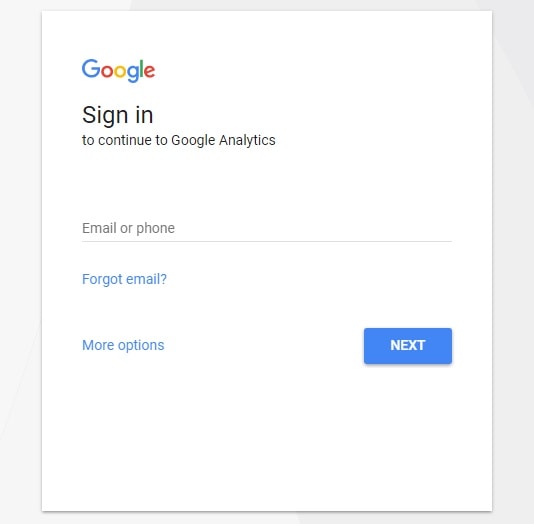
As a new user you will reach this page. Click on the button to sign up.

Once you have clicked Sign Up you will reach a page like this. There are a few things that you need to complete on this page to proceed.

What would you like to track? Select Website.
Next enter data for Account Name, Website Name, Website URL, Industry, Reporting Time Zone. All of these will identify your account.
Once you have completed those steps, scroll down and click on Get Tracking ID.
![]()
You will now have your tracking ID. Google gives instructions on where you should place your tracking ID on your website.
![]()
Copy the code and let’s go across to WordPress. (Leave the Google Analytics tab open as you may need to revisit it.)
You can install the code on your WordPress site in many ways however I believe in simplicity. I will show you how to install it with the Monster Insights plug in.
MonsterInsights
MonsterInsights is a tracking plugin that allows you to see your daily website performance. Using the free version of MonsterInsights you can see page views, which of your content is viewed the most and where your traffic comes from.
From your WordPress Dashboard, click on Plugins then Add New.
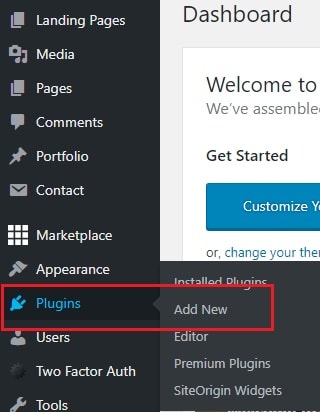
At the search bar type in Monster Insights. As a new user you will see a button that says Install Now.
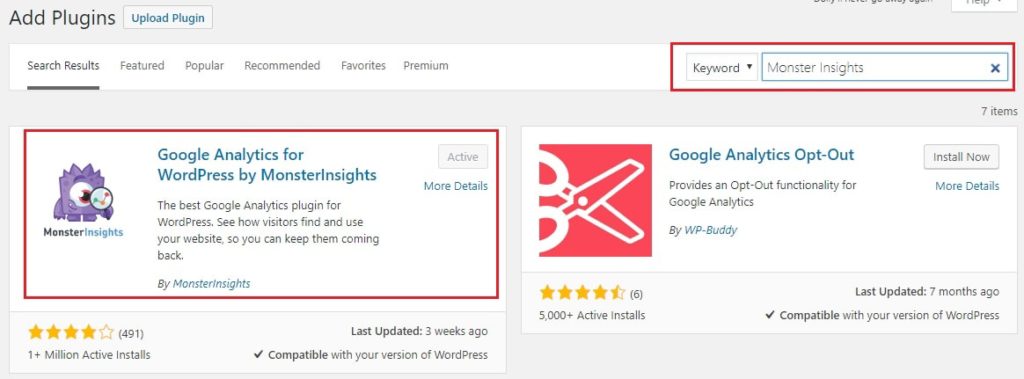
Once it has installed, the button will say Activate.
Once you have activated the plug in, the plug in will appear on the left side bar and it will be named Insights.
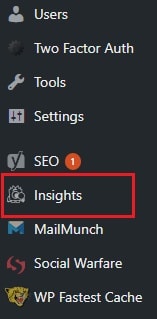
Hover over Insights and a second menu will appear. Select Settings.
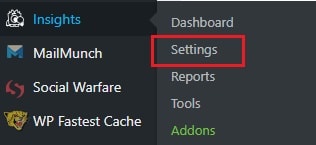
Click on the General tab. Click on the blue button Authenticate with your Google Account.

A pop up will appear instructing you to Authenticate Your Google Analytics Account With Monster Insights. Click Next.

A box will appear asking you to enter your Google Code. Click the button Click To Get Google Code.
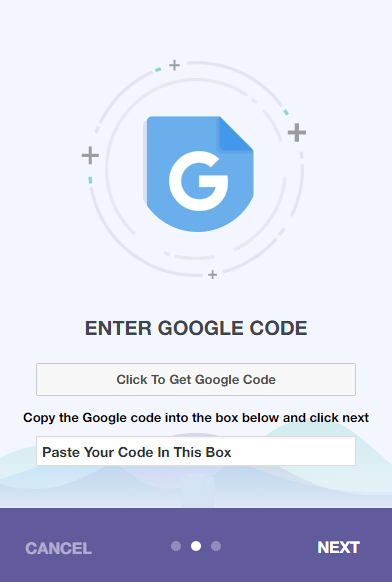
A popup will appear where Monster Insights will ask to get some of your Google Analytics data.
Click Allow.
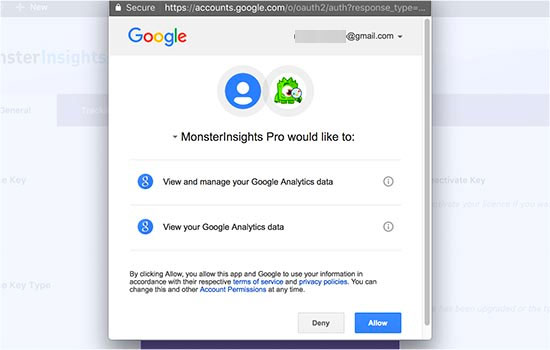
A line of code will appear on your screen. Copy the code and head back over to the Monster Insights popup where you will paste the code.
You will then be asked to select the profile you want to track. This will contain the data from your Google Analytics account and is the user profile you created that starts with UA.
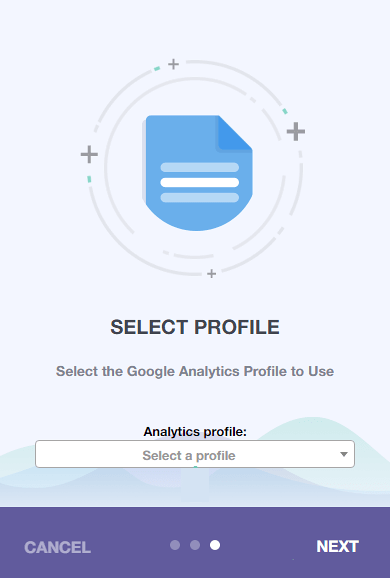
Select the profile and click Next. Now you’re all finished.
Great now you can access your Google Analytics data.
Google Analytics does not report data in real time for certain elements. Their platform takes 24 hours to update however you can see how many visitors you have on your website in real time. If you are not yet seeing any data, I would advise that you wait 24 hours for Google Analytics to take effect.
Your Goals
As a new blogger the following are goals that I would recommend you measure.
Page Views how many visitors you have had to your page in a day/month. You should work on increasing this number. To find this metric from your Google Analytics account go to Audience then Overview.

Bounce rate the percentage of time that your visitors remain on your site. The lower the bounce rate the better. You should work on writing valuable content that is at least 2000-3000 words so that your readers will be enticed to stay on your page longer.
Email Subscribers how many people opted into your email list over the course of a month. You should work on increasing this number.
You will find that as you measure these metrics and work on improving them, that the value of your blog increases and the potential to make money grows.
How To Blog With Your Goal In Mind
When creating content it is important to think about the end result.
There are many factors to consider when blogging with your goal in mind. So if your goal is to get more viewers to your blog, then of course promoting your blog is what you will focus on.
If your goal is to get a low bounce rate, then creating content that is rich in value, quality and length is what you need to pay attention to.
If your goal is to get more email subscribers then it is important to use strategies to help you collect email leads. Head on over to my blog post The Ultimate Email Marketing Strategy for Bloggers And Marketers where I list some mega tips to help you get started on your email marketing strategy.
Remember that by focusing on each of these goals, you are increasing your potential to make money which is your ultimate goal for blogging. Whilst making money from your blog should not be your motivating factor, it is something to keep in mind.
Your main motivating factor should be the user experience and adding value to them as ultimately it is those users who go on to buy your products or your recommendations.
How To Find Content That Your Audience Wants
The first thing you should know as you start blogging is that you are not blogging for yourself. You are blogging for an audience so you should answer to what your audience wants to read.
A good place to start is Google and I cover this more in depth in a recent article where I spoke about how to create topics that your audience is searching for and wants to read. You can read more of that article here.
You can also use a website called BuzzSumo to get inspiration for your posts. BuzzSumo actually lists the top most socially shared content on the web. You can search for your niche and see what posts got the most shares then model after that post and create your own.
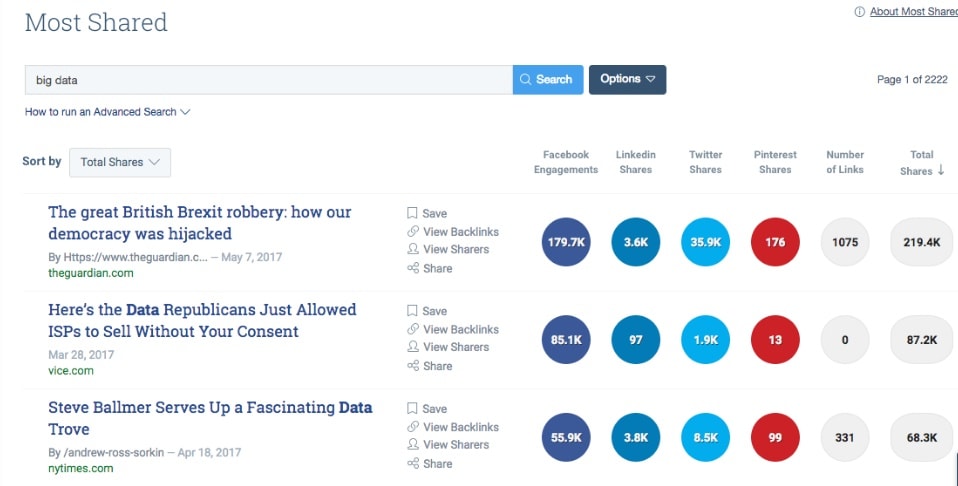
Another great place to find inspiration for content is Quora. This is a Q&A forum where people post questions on a wide variety of topics.

You can use the data from here to see which questions stand out the most in your niche, then write a blog post answering those questions. It is more likely than not that if people are asking those questions on Quora then there are many more people on the internet who want answers to those questions.
Some of the article types that do well are:
- How To articles
- List articles
- Case Studies
- Reviews
- Opinion and commentary
How To Start Writing Your First Blog Post
When you start writing your first blog post there are a few things that you should keep in mind:
Value
Your post should add value to the reader. It should aim to help the reader answer a question or direct them to a solution.
So when you write a post make sure that it is something that the reader will want to know about and of course share.
Do not fluff out your articles with meaningless blab. This can actually be a determining factor for how long your viewers stay on your website. It also tells Google whether your blog is informative and valuable as the more people that stay on a blog longer, the more Google sees it as being helpful and valuable.
Actionable
If you are writing How To articles, make sure that your content is actionable. By this I mean, that your content should inspire your readers to take action to implement something that you are teaching.
The steps should therefore be easy to follow.
Include diagrams if you have to and be specific.
In Depth
I always find that posts with a lot of detail on a topic gets the most shares on my blog.
When people read blogs they want the specifics or the essence of the topic.
So avoid hitting the surface. That’s for lazy people.
Take some time to add meat to the bones. Dig deeper. Let’s see how this is done in practice.
First you start by turning on the television
This is very shallow statement. If you write a basic sentence like this you are assuming that your readers know how to turn on the television. So it is essential that you put yourself in the shoes of the reader. Be mindful that not everyone will have the same level skillset as you do. So what else can you do?
First you start by turning on the television which is found on the left side of the room. Use the black button at the bottom of the television set and press it to turn on the set.
This is now a better sentence with more detail.
Do you see what I have done?
I have given precise instructions to the reader to find the television set, find the button and then turn it on.
That is how your blog posts should be structured. And this formula can be applied to any subject area that you are writing about.
Take a little bit more time to extract your sentences which will then add more value to the article for your reader.
How Many Blog Posts Should You Write?
There is no hard and fast rule with the number of blog posts you should write every day or week.
You want to be very realistic and have a plan which you can stick to. When you have a plan it is so much easier to know what needs to be done to get the job done.
You do not want a plan that will cause too much overwhelm. If you can blog once a day then go for it. If you find that blogging once a week and leaving other days to promote content works for you, then that is ok too.
Whatever your plan for blog writing is, make sure that it involves a schedule to write and promote that content consistently because at the end of the day, your blog posts make no impact if other people are not reading it.
How To Monetise Your Blog
Ahhhhhhhh! Monetising the blog to make money.
I see so many people who wait until they have built up enough traffic on their blog to start monetising it.
I also see other bloggers who suggest that you should not monetise your blog until you have at least 10000 monthly page views.
Well I am here to debunk all those myths because I have proven that you can actually make money from your blog from the very start with less than 10000 monthly page views.
As I am writing, I have about 4000 monthly pageviews having started my blogging journey about a month and a half ago.
I started monetising my blog posts from day one and have relied on affiliate marketing which is where I would recommend that all beginners start.
Other ways that you can monetise your blog include:
- Advertisements
- Your own products or services
Affiliate Marketing
If you have never heard about affiliate marketing, then read my article Affiliate Marketing For Beginners, to get a detailed view on what affiliate marketing is.
In a nutshell, affiliate marketing is promoting other people’s products for a commission when a sale is made. Essentially your blog posts may recommend a product which you are an affiliate of. If someone clicks on your affiliate link to check out the product and they buy, then you earn a percentage of the sale.
You can find products to start affiliate marketing at the following sites which are free to join:
- ShareASale
- Panthera Network
- Rakuten Marketing
- Commission Junction
- Clickbank Read my article on The Ultimate Guide To Clickbank Affiliate Marketing for help on how to use Clickbank
- Amazon Associates
You can also recommend products that you use in your day to day life if there is an affiliate program attached to it. So for example, Aweber has an affiliate program. Because it is an email marketing software that you may use as a blogger, you can recommend it to other readers who may be bloggers getting started with email marketing.
LeadPages is another software that has an affiliate program attached to it. You can also include recommendations within your blog posts or write review articles about it to start earning commissions from their program.
For more high paying affiliate marketing programs that pay big commissions you can read my article here.
Advertisements
You may or may not want to use advertisements on your blog at the start. This is a decision that only you can make.
However before you start applying to advertising networks like Google Adsense or Ad Maven there are a few things you need to be mindful of.
Content quality if your content is less than 300 words your content is considered to be thin and of poor quality. No one will want to advertise on your blog and this can be grounds for rejection.
Webdesign if the design of your website is unappealing, you will have a high bounce rate and hardly attract viewers to your site. Therefore choose a design that is attractive and minimal. Ensure that it is easy to navigate your site. A user friendly site will always encourage visitors to return to your site and share its content and is a good reason why your application can be accepted.
Backlink relevancy backlinks are a way to build your website’s authority. A backlink is an incoming website link from one external website to another. So if an authoritative website such as Wikipedia links to your site, Google will assess that your site is of a high quality. Therefore if you are using backlinks, make sure that they are coming from sites which have a high authority. This can improve your chances of your advert applications being accepted.
Your Own Products Or Services
Do you have a product or service that you want to talk about on your blog?
This is a great way to start monetising your blog so you can start reaching out to your audience to purchase from you.
Products and services can be varied.
So you may have a consultancy service, a course, coaching or mentoring which you can advertise on your blog.
How To Promote Your Blog Posts To Get Eyes On Your Blog
Finally, your blog would not matter if no one is seeing it.
So as a beginner the best way you can get eyes on your blog is to promote it. Here are some ways you can do that:
- Guest Blogging
- Content Distribution
- SEO
As I mostly use guest blogging and content distribution to promote my blog content I will focus on that. If you are interested in learning more about SEO then Moz is a great blog that you can refer to.
Guest Blogging
Guest blogging is putting your content on someone else’s website to borrow their audience and ultimately their traffic.
It is the best way that you can gain a lot of traffic to your own blog but only if you do it right. Guest blogging also helps you to gain authority and recognition in your niche. It helps you to network with other bloggers and influencers and gain email subscribers.
So let’s take a look at what you can do to start guest blogging.
Reach out to other bloggers.
An easy way to find blogs for guest posting is to use Google. I used the keywords blog write for us.
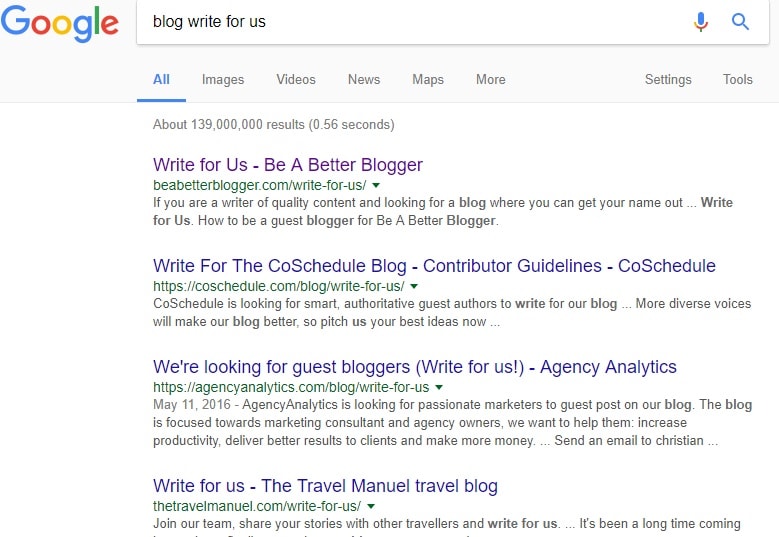
It will be useful to have some type of spreadsheet to track your efforts. I have set up my own tracking using these key headlines
Niche Topic 1 Topic 2 Topic 3 Submission URL Email Request Date Follow Up Date
Make a note of all the guest post requests you have made and don’t forget to follow up with the blogger about three days later.
I would also recommend that you be very selective about the blogs that you write for. You want to write for blogs that have a high audience reach and has a high quality.
It is difficult to know how much traffic a site gets unless you use a premium service. But you can gauge the quality of a website using online analytics tools from Alexa.com to look at the global rank of a site. Simply type in the website URL and Alexa will provide some statistics on the website. Typically a good rank is anything in the top 100,000.

You can also use Moz.com to check the webpage’s domain and page authority. High page authorities are great but a site with a domain authority and page authority of 20 and over is ideal.
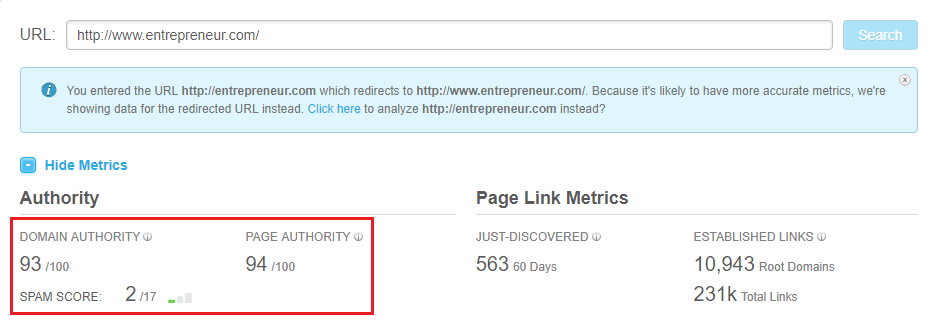
Pitching
Once you have your list of blogs to write for, it is time to pitch to them. Keep your pitch simple and to the point.
A good pitch goes a long the lines like this:
Hey [blogger’s first name]
My name is [your name] and I am the creator of [Your blog or business name]. I write on the topic of [your niche] and I hoping that I can write for you and help your audience by providing some great value.
Here is a sample of my work [link to some of your articles]
I have also guest posted on [name some authority sites that are relevant. This shows that you have been accepted as a contributor elsewhere]
My ideas for blog posts are [usually blog owners want 2-3 post ideas that they can consider].
Please let me know if you think this is a good fit for your blog.
I wait to hear from you.
Thank you for your time and consideration.
[Your name]
Content
When you do get a response from the blogger make sure that you read their blog submission guidelines and follow them.
Nothing hurts you as a guest blogger than breaking the rules as this only puts you in a bad light and could potentially hurt your relationship with the blogger.
After the Post
Once you have submitted your post and it is published be sure to do your part and respond to any comments left by the reader’s audience.
Although you are tapping into someone else’s audience you are responsible for promoting your own guest blog post so the onus is on you to share the content around, whether it is with your email list or social media.
Content Distribution
Content Distribution is another way for you to get the word out there that you are a blogger.
This simply involves sharing your post on social media sites such as Pinterest, LinkedIn, YouTube, Twitter or Facebook.
Any of these sites are great forums for sharing your blog post in any niche.
I use Pinterest to share my content and do so on a daily basis by joining relevant group boards and pinning my blog post to them.
Pinterest is great for driving traffic to blogs. I actually got started using Pinterest after learning all about the value of it by following the strategies laid out in the Pinterest Traffic Avalanche course.
To be successful with any of these two methods for driving traffic takes a lot of work and consistency so be sure that you set out time in your blogging schedule to complete these tasks.
Alas!
We have made it to the end.
This blogging guide should prepare you for the next three months of blogging to success. To wrap this up here is a summary of the key steps you should take to start a successful blog:
- Set up your domain name and web hosting
- Design your blog so that it is attractive and easy to navigate
- Monetise your blog
- Write content that your audience wants to read. No one cares about you (sorry to be so harsh😜)
- Write down your blogging goals
- Get a blogging plan and stick to it
- Get quality traffic to your blog
- Build your email list and treat them like your friends
- Network with other bloggers in your niche
- Enjoy the ride and most importantly BE CONSISTENT!
Cheers,

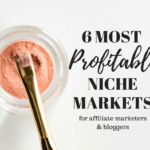 Previous Post
Previous Post Next Post
Next Post
